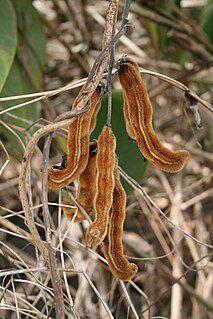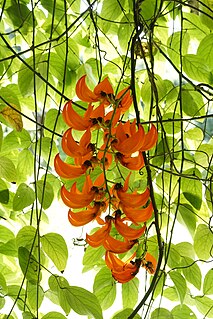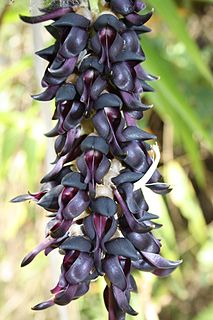This page is based on this
Wikipedia article Text is available under the
CC BY-SA 4.0 license; additional terms may apply.
Images, videos and audio are available under their respective licenses.

The proteolytic enzyme mucunain is a protein in the tissues of certain legumes of the genus Mucuna, especially velvet bean.

Morpho peleides, the Peleides blue morpho, common morpho or the emperor is an iridescent tropical butterfly found in Mexico, Central America, northern South America, Paraguay and Trinidad.
Some authorities believe that peleides is a subspecies of Morpho helenor.
Drift seeds and drift fruits are seeds and fruits adapted for long distance dispersal by water. Most are produced by tropical trees, and they can be found on distant beaches after drifting thousands of miles through ocean currents. This method of propagation has helped many species of plant such as the Coconut colonize and establish themselves on previously barren islands. Consequently, drift seeds and fruits are of interest to scientists who study these currents.
Itching powder refers to a group of powders or powder-like substances that induce itching when applied onto human skin. This is usually done as a practical joke or prank to an unsuspecting victim.
Flame of the forest is a common name for several plants and may refer to:
Inga mucuna is a species of legume in the Fabaceae family.
It is found in Colombia and Panama.
It is threatened by habitat loss.
Syconycteris is a genus of megabat in the family Pteropodidae. There are three described species at present, with more likely to be added. Members of this genus are found in Indonesia, New Guinea and Australia. Their diet mainly consists of nectar and fruit, making them important for pollination and seed dispersal in their environment.

Clanis bilineata, the two-lined velvet hawkmoth, is a moth of the family Sphingidae first described by Francis Walker in 1866.
M. nigricans may refer to:

Hasora discolor, the green awl, is a butterfly of the family Hesperiidae. It is found as several subspecies in Australia, the Aru Islands, Irian Jaya, the Kei Islands, Maluku and Papua New Guinea.

Anticarsia irrorata, the owl moth, is a species of moth in the family Noctuidae. It is native to the Old World tropics.
Edward Johnston Alexander was an American botanist who discovered three species and one genus, but only named one of them. He was born in Asheville, North Carolina and studied at North Carolina State University from 1919 to 1923, though he failed to graduate. He was a longtime assistant and curator at New York Botanical Garden, originally under the guidance of John Kunkel Small. While at the Botanic Garden, he served as an editor of the Garden's botanical journal Addisonia for about thirty years, until the journal ceased publication in 1964.

Mucuna bennettii, commonly known as New-Guinea creeper or scarlet jade vine, is a species of flowering plant in the family Fabaceae, that is native to Papua New Guinea.
Mucuna bracteata is a leguminous plant. It is a nitrogen-regulating plant that is used in agroecosystems operating around certain types of agricultural plant systems including: rubber trees, oil palm, citrus and coconut. M. bracteate is a cover crop which helps to cover and shield the soil from weeds or plants, as well as providing rapid growth for existing agricultural crops, preventing soil erosion, and providing nitrogen fixation. The Mucuna bracteata crop grows about 10–15 cm/day in conditions similar to those that rubber and palm oil plants thrive in.
Cleora munditibia is a moth of the family Geometridae. It is found on Fiji.

Mucuna monosperma is a large woody climber from the family Fabaceae. It is found in India, including the Eastern Himalayas, the Northeastern states and the Andaman and Nicobar Islands, Sri Lanka, Bangladesh, Myanmar and Thailand.
Mucuna sanjappae is a perennial woody twiner from the family Fabaceae. It is endemic to India (Maharashtra), having been recorded from Junnar in Maharastra.








